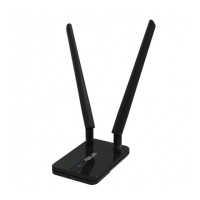11
COFDM (for 802.11a or 802.11g)
Signal power alone is not enough to maintain 802.11b-like distances in an
802.11a/g environment. To compensate, a new physical-layer encoding
technology was designed that departs from the traditional direct-sequence
technology being deployed today. This technology is called COFDM (coded
OFDM). COFDM was developed specically for indoor wireless use and oers
performance much superior to that of spread-spectrum solutions. COFDM
works by breaking one high-speed data carrier into several lowerspeed
subcarriers, which are then transmitted in parallel. Each high-speed carrier is
20MHzwideandisbrokenupinto52subchannels,eachapproximately300KHz
wide. COFDM uses 48 of these subchannels for data, while the remaining four
are used for error correction. COFDM delivers higher data rates and a high
degree of multipath reection recovery, thanks to its encoding scheme and
error correction.
EachsubchannelintheCOFDMimplementationisabout300KHzwide.At
thelowendofthespeedgradient,BPSK(binaryphaseshiftkeying)isused
toencode125Kbpsofdataperchannel,resultingina6,000Kbps,or6Mbps,
data rate. Using quadrature phase shift keying, you can double the amount of
dataencodedto250Kbpsperchannel,yieldinga12Mbpsdatarate.Andby
using16-levelquadratureamplitudemodulationencoding4bitsperhertz,
you can achieve a data rate of 24Mbps. The 802.11a/g standard species
that all 802.11a/g-compliant products must support these basic data rates.
The standard also lets the vendor extend the modulation scheme beyond
24Mbps. Remember, the more bits per cycle (hertz) that are encoded, the more
susceptible the signal will be to interference and fading, and ultimately, the
shorter the range, unless power output is increased.
Default Key
This option allows you to select the default WEP key. This option allows you to
use WEP keys without having to remember or write them down. The WEP keys
generated using the Pass Phrase is compatible with other WLAN products. The
Pass Phrase option is not as secure as manual assignment.
Device Name
Also known as DHCP client ID or network name. Sometimes provided by an ISP
when using DHCP to assign addresses.
DHCP (Dynamic Host Conguration Protocol)
This protocol allows a computer (or many computers on your network) to be
automatically assigned a single IP address from a DHCP server.

